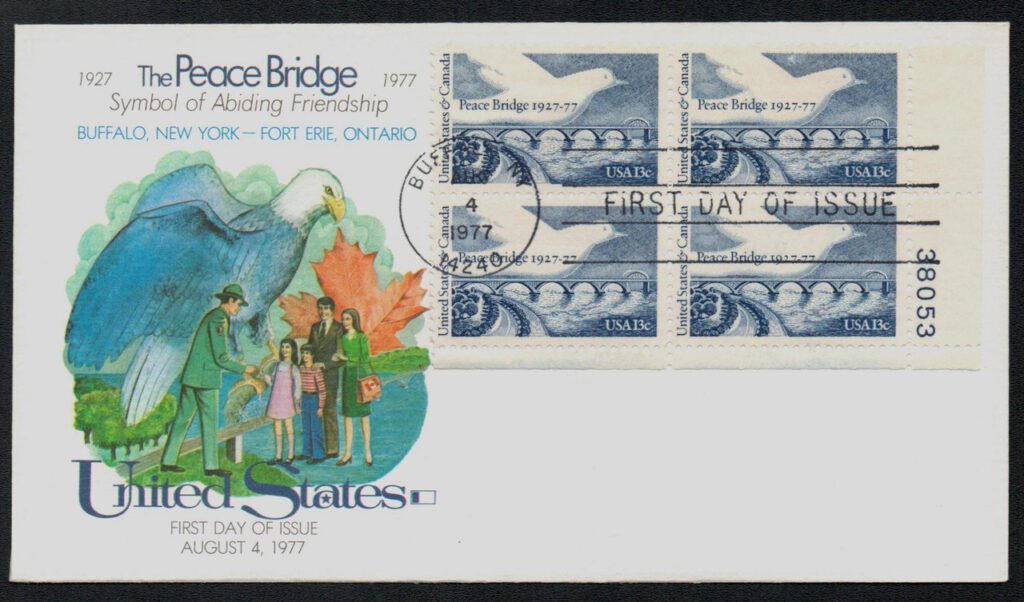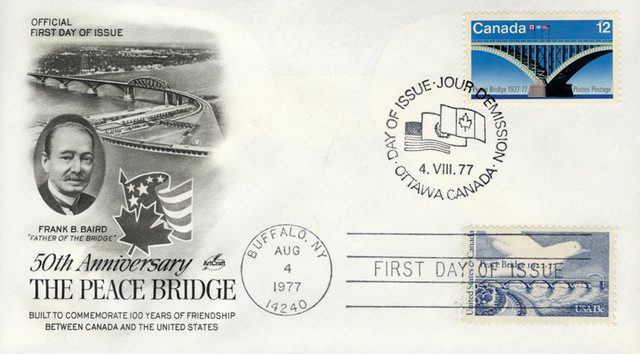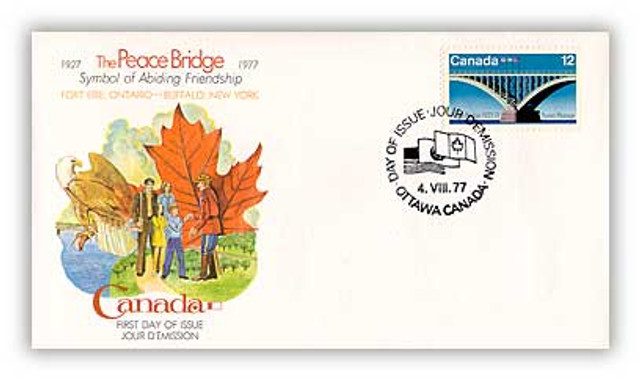On August 7, 1927, the Peace Bridge linking the US and Canada was dedicated by representatives from both countries and the United Kingdom.
In the 1800s, ferries frequently crossed the Upper Niagara River between Fort Erie, Ontario, and Buffalo, New York. However, too many boats at once created a bottleneck and strong currents and ice made passage dangerous during several months of the year. The Railway Bridge opened in 1873 to make this route safer.
But by the early 1900s, the Railway Bridge wasn’t enough, as it didn’t accommodate pedestrian or car crossing. In 1919, businessman Alonzo Clark Mather began to campaign for a new bridge that would not only increase traffic but also commemorate a century of peace and cooperation between the two nations.
Working with Frank Burkett Baird and William C. Eckert, Mather got the bridge idea approved by the International Joint Commission. The $4.5 million needed to fund the bridge was raised largely through bond issues. Construction broke ground on August 17, 1925. The new bridge would be built about .6 miles south of the International Railway Bridge.
Building the bridge was a difficult task, as it was over water with a current of up to 12 miles per hour. The completed bridge was composed of 9,800 tons of structural and reinforced steel and spanned 5,800 feet.
The bridge’s chief engineer, Edward Lupfer, drove the first car across the bridge in March 1927. The bridge then opened to the public on June 1 of that year, with the official ceremony to be held two months later.
The official opening ceremony held on August 7, 1927, was an international affair. The main speaker of the day was Edward, prince of Wales who gave a brief, but eloquent speech:
“It makes me very happy to be present with the prime minister of Great Britain and the prime minister of Canada on the occasion of the formal dedication of this bridge, which commemorates the peace that has now happily endured between the British Empire and the United States for more than a century. May this bridge be not only a physical and material link between Canada and the United States, but may it also be symbolical of the maintenance of their friendly contacts by those who live on both sides of this frontier. “May it serve also as a continual reminder to those who will use it and to all of us that to seek peace and pursue it is the first and the highest duty, both of this generation and those that are yet to come.”
Other speakers at the ceremony included Stanley Baldwin (the prime minister of Great Britain), Mackenzie King (prime minister of Canada), Howard Ferguson (premier of Ontario), Milton Ross (lieutenant governor of Ontario), Charles Dawes (vice president of the United States), Frank B. Kellogg (US secretary of State) and Alfred E. Smith (governor of New York). Vice President Charles Dawes had a particularly moving speech:
“What has been said of the relations of the English speaking peoples and what I am to say is but the verbal acknowledgment of a common feeling, shared equally and alike by the Englishmen, Canadians, and Americans who are gathered here. We speak the same language, we cherish the same ideals of citizenship, we hold a common principle in government, of individual liberty under the law.
“The foundation of this great peace structure which we dedicate today rests upon the firm bedrock of the Niagara, and the peace of the English speaking peoples is as firmly based upon common instincts and ideals. The instinct of self-preservation — the most deep-seated of mankind — binds us together, and in that unbroken tie is that ultimate guarantee of the safety and progress of Western civilization. That bond will never break.”
In addition to the speeches, three military bands and 200 singers added to the day’s presentations. An estimated 100,000 people were present for the ceremony on Buffalo’s west side. The ceremony was broadcast on dozens of radio stations and is considered one of the first “round the world” radio broadcasts, reaching as far away as Australia. It’s been estimated some 50 million people listened to that broadcast.
The new Peace Bridge made Buffalo and Fort Erie the main port of entry to each nation from the other. At the time of its completion, it was the only automobile bridge on the Great Lakes. Although newer bridges have been built, the Peace Bridge remains busy, carrying an average of 4,000 trucks on a daily basis.
Click here to see video from the dedication ceremony and click here to see photos.
| FREE printable This Day in History album pages Download a PDF of today’s article. Get a binder or other supplies to create your This Day in History album. |
Discover what else happened on This Day in History.







Outstanding recap of everything one would want to know about the Peace Bridge and its dedication. It just so happens that I was married on Aug 7, 1977, so this is my my wedding anniversary as well. Too bad (for me) that the FDOI wasn’t 8-7-1977 instead of 8-4-1977. Oh well.
I know of no other two nations that share such similar ideals….that is why we are enduring friends…we even fought as allies in 2 world wars and Korea. We are lucky to have each other as neighbors.
Love those Canadians!
…. as we love those Americans!
I have crossed that bridge countless times since my childhood when going to see the Niagara Falls on the Canadian side, usually twice a year. It’s always exciting and interesting crossing the border. Of course, crossing has evolved over the years due to heightened security and pandemics!
I can’t imagine French speaking Canadian citizens were pleased with the remarks of the American vice president regarding “English speaking peoples.” I would not expect such narrow mindedness from such a high ranking official in today’s more informed leadership.
Peace & Love, I am flying freak flags only born in 1950 staying true to the Lord. He’s waiting for you all to see, who owns 50% of General Motors. Keep an open mind, ears listening and free from bias.